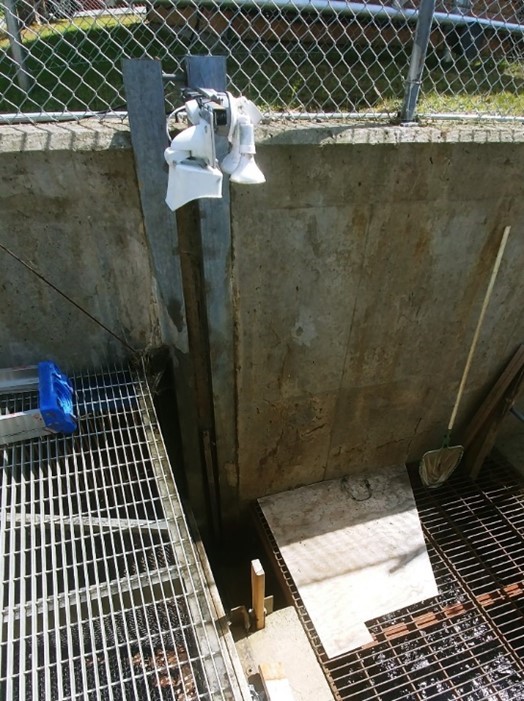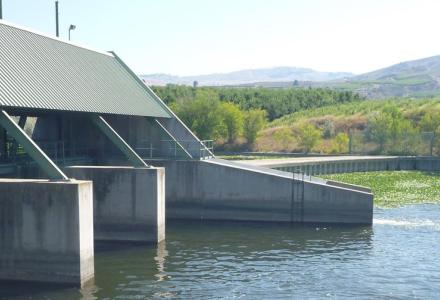
Alewives continue to return to the St. Croix River in greater numbers, with a 2020 fish count exceeding 2019’s by more than 25 percent and the highest totals since 1996.
The fish count, which ran from April through July 2020, recorded 611,907 alewives passing through the Milltown Dam fishway, located near the mouth of the St. Croix River between the communities of St. Stephen, New Brunswick, and Calais, Maine. This is the latest example of a continuing trend of more alewives returning to the river. The 2019 count saw 486,500 alewives pass Milltown, which was a dramatic increase over 2018 numbers. Researchers also counted 29 American shad, 10 American eels, one white sucker and one smallmouth bass passing through the fishway in 2020.
The COVID-19 pandemic restricted physical access to the fishway’s research equipment, but a remote video feed set up by dam operator New Brunswick Power was used to keep an eye on the passageway and carry-out the fish count. Despite some technical hiccups and periods where the video feed cut out, the International St. Croix River Watershed Board considers this year’s count a success.
The 139-year-old Milltown Dam is the first barrier fish must traverse to enter the St. Croix River from the Atlantic Ocean. The dam is equipped with a fish passageway that features a research trap to help with counting fish that pass through.
New Brunswick Power, which owns the dam, is seeking direction from provincial, state and federal governments on the approvals needed to decommission and remove it. The company says the Milltown Dam does not generate enough electricity to be financially viable with upgrades it needs to continue operating. If the dam is decommissioned and removed, New Brunswick Power says it will allow for the restoration of Salmon Falls and about 16 kilometers (9.9 miles) of the St. Croix River.

The IJC has helped fund fish counts since 2011 through its International Watersheds Initiative, though the fish counting project dates back to 1981, when inadequate fish passageways were upgraded.
The St. Croix International Waterway Commission has managed the research trap and fish count since 2015; other organizations like the Fisheries and Oceans Canada and the Atlantic Salmon Federation handled it previously. New Brunswick Power also has worked alongside the St. Croix Waterway Commission and Fisheries and Oceans Canada to manage flows through Milltown Dam to attract fish to the passageway on the dam, according to a 2019 Milltown Fishway Research Trap Report.
When the Milltown Dam fishway was first opened in 1981, the St. Croix River supported runs of more than 2 million alewives, along with a variety of other fish that live part of their lives in the ocean.
Subsequent concerns about the impact of alewives on the smallmouth bass sport fishery led the state of Maine to close fish passage on the river at the Woodland and Grand Falls dams in 1995, dropping the returning number of alewives down to a low of 900 by 2002. New Brunswick continued assisting alewives up the river, and passageways on dams on the Canadian side of the river remained open. After a 2005 paper from the IJC’s St. Croix Board showed that alewives had no negative impact on smallmouth bass, Maine started to reopen its fish passageways in 2008. By 2013, the state had fully reopened passageways on the dams along the US side of the river, with the support of the New Brunswick-based Peskotomuhkati Nation and its Maine counterparts, the Passamaquoddy (Peskotomuhkati) tribes of Pleasant Point and Indian Township.
Alewives have sustained the Peskotomuhkati communities culturally, spiritually and as a food source for centuries, and as such their continued restoration is a point of interest for Indigenous peoples along the river. Alewives also were important as food to other communities that were built along the riverbanks.
Alewives are a major source of lobster bait for Canadian and US fisheries, and a major keystone species that provide food for numerous fish and wildlife species such as eagles, puffins, bears, mink, cod, bluefish, striped bass and even whales.
Before the dams, the St. Croix River also was a major habitat for other fish that live part of their lives in the Atlantic Ocean, including American eels, shad, Atlantic salmon and sea lamprey. While shad and eels can still be found in smaller numbers in the river, the salmon and lamprey have not made their way back past Milltown Dam based on 30-plus years of fish counts. Sean Ledwin, director of the Maine Sea Run Fisheries and Habitat Division of the Maine Department of Marine Resources, told the IJC in 2018 that the river has the potential to be the largest alewife fishery on the east coast with adequate fish ladders and other ways for alewives to move upriver.

Kevin Bunch is a writer-communications specialist at the IJC’s US Section office in Washington, D.C.



